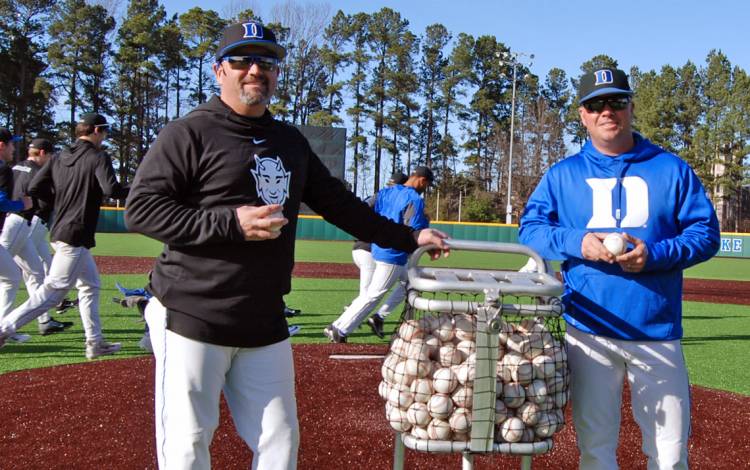Meet Duke’s Busiest Arms
For baseball and softball coaches, throwing batting practice is an in-demand skill

When Jason Stein faces batters at Duke’s Jack Coombs Field, he doesn’t mind if they smack his pitches around the park.
If they send his fastballs or change-ups sailing over the fence, even better.
“When the ball is flying out of the park, you have a sense of pride,” said Stein, Duke assistant baseball coach. “I’m never worried about getting lit up. It just means we’re training these guys right.”
Stein, and fellow assistant coach Josh Jordan, are the two members of the Duke baseball coaching staff tasked with throwing batting practice. For the Duke Softball program, those duties are handled by head coach Marissa Young and assistant coach Lacey Waldrop.
While there are plenty of jobs that require specialized skills in an athletics department, few are as essential or often underappreciated outside of their sport as the ability to throw high-quality batting practice.
“These coaches have a lot of practice, so they’re spot on with everything that they do,” said Duke senior baseball player Kennie Taylor. “There aren’t that many good batting practice pitchers around, so having two of them in our program is really special.”
For Duke’s baseball and softball programs, batting practice is a major part of nearly every practice, which means having members of the coaching staff who can throw a seemingly endless amount of consistent pitches is very important.
In fact, throwing consistent batting practice pitches can end up being what lands a coach a job, as Jordan can attest. He recalls that when his college playing career ended at Catawba College, his former coach offered him a spot on the coaching staff provided he could learn how to throw good batting practice.
He recalls that when his college playing career ended at Catawba College, his former coach offered him a spot on the coaching staff provided he could learn how to throw good batting practice.
“It was pretty much a prerequisite,” Jordan said.
Regardless of the sport, there are a few qualities a good batting practice pitcher must have. First, the 200 to 300 pitches that can make up a session must be consistently on-target and of a similar speed, usually slightly slower – baseball batting practice pitches are usually in the 60-miles-per-hour range – than what players would face from normal competition. Most practices unfold according to a tightly-scripted schedule, so each moment is accounted for. If hitters need to wait for good pitches, it can derail the flow of the session.
Also, the pitches need to walk the line between being challenging, yet hittable enough so as to not shake a hitter’s confidence. The point is to make batters comfortable making contact, but not comfortable enough so that live pitching will be too hard.
Mixed in with fastballs, Duke baseball coaches throw curveballs that dive downward or spin to one side as they approach the plate. They’ll also weave in change-ups that come in deceptively slow, forcing a batter to sharpen his eye and discipline.
“Every hitter has holes,” Stein said. “If you can pitch to those holes, you can improve their weaknesses. But you’re not trying to get them out, you’re trying to assist their development.”

For Duke Assistant Softball Coach Lacey Waldrop, striking a balance between giving hitters a challenge and building their confidence was tough.
Waldrop has been with the Duke program for each of its two seasons, but prior to that, she was a pitcher at the University of Oklahoma, throwing every pitch with the desire to get the batter out.
“At the beginning, I was not that good at throwing BP,” Waldrop said. “It was so different than regular pitching. It was hard to slow it down and get it in there.”
Both Waldrop and Duke Head Coach Marissa Young have pitching backgrounds, so they share the duties of throwing batting practice, something that happens at nearly every team workout.
Waldrop said she’s now mastered the skill of throttling back the speed of her pitches – from around 62 miles-per-hour to around 55 – and using different spins so they don’t dive or cut with too much pace.
“You don’t want it too fast or too slow,” Waldrop said. “But I think you have to have the ability to ramp it up when you want to make it more game-like and have the ability to hit corners and move it side-to-side is also helpful.”
While there is an art to throwing good batting practice, most coaches acknowledge that it’s an endangered one.
Visit practice at Jack Coombs Field on West Campus or Duke’s new softball facility on East Campus and you’ll hear the mechanical hum of pitching machines.
Using fast-spinning wheels to shoot balls at home plate, these machines can produce pitches with the velocity and movement that approximate live pitching. Jordan, Stein and Waldrop all admit that the new technology can do things their pitches can’t.
“I’m not throwing that hard, I’m not throwing curveballs like they’re going to see in the ACC, I’m not throwing changeups like they’re going to see in the ACC,” Stein said. “We have machines that can do that.”
For both Duke’s baseball and softball teams, the ratio of batting practice pitches thrown by coaches versus those provided by machines has swung dramatically in the machines’ favor in recent seasons.
While technology is biting off some of their workload, don’t expect the value of good batting practice pitchers to ever fully disappear.
“As a hitter, what you’re able to pick up comes from the body movements of the pitcher,” Waldrop said. “That part is taken away with the machine. I think it’s nice to have the two. I don’t think throwing batting practice will ever go away.”
Have a story idea or news to share? Share it with Working@Duke.